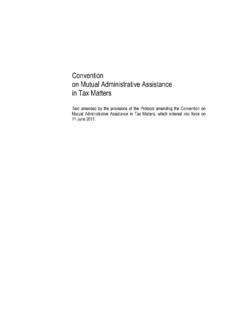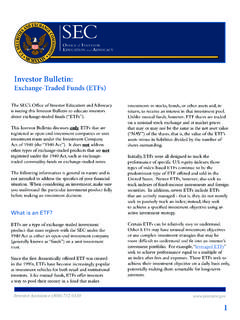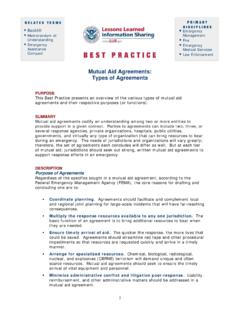Transcription of Comparing Exchange Traded Funds to Mutual Funds and …
1 In an era when investment options may appear endless, the growing popularity of Exchange Traded Funds (ETFs) has taken the investment industry by storm. With over $150 billion in assets under management as at January 31, 2018, which represents a per cent increase since January 31, 2017, investments in ETFs continue to disrupt the investment landscape in Canada. There are currently over 550 ETFs from 25+ individual ETF sponsors available to Canadian provide greater understanding of the growing popularity of these investment vehicles and to help determine whether ETFs may be appropriate investments for your portfolio, we compare the advantages and disadvantages of investing in ETFs with those of Mutual Funds , individual stocks and bonds. What is an ETF? An ETF is a specific type of Mutual fund. Like a conventional Mutual fund, an ETF pools money from many individual investors with similar investment goals to buy a variety of securities and combines them into a portfolio.
2 A primary difference between ETFs and conventional ETFs 101 Comparing Exchange Traded Funds to Mutual Funds and Stocks and Bonds020406080100120140160 Jan. 2018 Dec. 2016 Dec. 2014 Dec. 2012 Dec. 2010 Dec. 2008 ETF Assets$ Billions A decade of growth ETF assets in CanadaSource: CEFTA Monthly Report, as at January 31, 101 | Comparing Exchange Traded Funds to Mutual Funds and Stocks and Bonds | 2 Table 1: Comparative overview of ETFs to Mutual Funds , stocks and bondsmutual Funds is the way by which units of each are bought and sold. Like individual stocks and bonds, ETF units are generally listed on a stock Exchange and bought and sold through a broker, while Mutual Funds are purchased and sold through a Mutual fund dealer. The vast majority of ETFs seek to track a benchmark or replicate the performance of well-known indices by holding the same securities as the index in proportionate amounts or by holding a sampling of securities from the index structured to mimic the performance of the index.
3 Indices cover a broad range of securities including stocks, bonds and commodities (like oil and gold). A more recent trend sees a significant increase in smart beta ETFs that may incorporate active management into security selection. Examples of smart beta ETFs include low volatility, high dividend or equal weight strategies that aim to achieve a specific investment objective or strategy. ETFs have the potential to play a complementary role in your portfolio, especially when your investment strategy includes a long-term fundsStocksBondsHolding costsMER payable by the ETF (but usually lower cost than Mutual Funds )MER payable by the Mutual fundNo costs to holdNo costs to holdTransaction costsBrokerage commission to buy and sellMany options to buy without being required to pay a commissionBrokerage commission to buy and sellBrokerage commission to buy and sellDiversification & ease of building a portfolioInstant diversification available in one purchaseInstant diversification available in one purchaseProper diversification may require significant amounts of capital and feesProper diversification may require significant amounts of capital and feesCosts incurred when rebalancingBrokerage commission (but cheaper than stocks or bonds)
4 Switches within fund families at no cost possibleBrokerage commission on each stock bought or soldBrokerage commission on each bond bought or soldTransparencyMost publish holdings dailyPublish full holdings twice a yearSecurities chosen by the investorSecurities chosen by the investorDistributions/interest reinvestmentDistributions and interest can be automatically reinvested. Distributions can be reinvested to the nearest whole unitGenerally, distributions and interest can be automatically reinvested. Distributions can be reinvested in the Mutual fund to the nearest pennyDistributions must be manually reinvestedInterest must be manually reinvestedNote: Green shading in Table 1 indicates the preferred option for many investors; yellow shading indicates the intermediate option and red shading indicates the least preferred 101 | Comparing Exchange Traded Funds to Mutual Funds and Stocks and Bonds | 3 Like Mutual Funds , ETFs can provide access to a diversified portfolio of securities.
5 For example, ETFs that track broad indices can provide exposure to hundreds or sometimes thousands of individual securities. Some ETFs may also invest in other ETFs to create strategically diversified portfolios that offer exposure to multiple asset classes in a single, cost-effective investment. A Mutual fund can also offer exposure to a broad range of securities across asset classes, sectors and locations, with some Funds employing a fund-of-fund strategy, which allows it to invest in underlying Mutual Funds instead of investing directly in individual securities. For investors looking for cost savings, some Mutual Funds offer a hybrid approach by providing access to professionally managed portfolios built exclusively with ETFs. The flexible mandates of ETFs and Mutual Funds and their ability to provide broad diversification with ease helps explain the popularity of these investments and why they can form a core component of many investors portfolios.
6 When investing in stocks and bonds directly, building a customized portfolio is quite easy since you can exclude securities considered unattractive to the investor. However, achieving broad diversification is often more difficult when compared to ETFs or Mutual Funds . A greater amount of capital is typically required, and many investors may not have the amount of time, expertise or resources to build strategically diversified portfolios on their ETFs 101 | Comparing Exchange Traded Funds to Mutual Funds and Stocks and Bonds | 4 MERC ommission Cost for Each Buy and SellTotal Commissions to Buy in Year 1 and Sell in Year 5 MER Per YearTotal Costs After 5 YearsScenario 1: $1,000 to investCanadian Equity $ $ Equity $ $ $ $ Individual $ $ $ 2: $10,000 to investCanadian Equity $ $1, Equity $ $ $ $ Individual $ $ $ 3: $100,000 to investCanadian Equity $2, $10, Equity $ $ $ $ Individual $ $ $ Mutual Funds , ETFs charge a management fee.
7 ETFs can be either actively or passively managed, and the Management Expense Ratio ( MER ), which reflects the amount of fees and expenses paid by the ETF (or Mutual fund), are frequently lower on ETFs an advantage that has the potential to provide a positive effect on the ETF s performance over time. Individual stock and bond purchases are not subject to ongoing management fees or operating expenses, but similar to ETFs, will usually have commissions charged by a broker whenever they are bought or sold. Bonds will have a spread added, which is the cost the broker adds (subtracts) to the price when they sell (or buy) for a client. If you trade stocks, ETF units or bonds frequently, the commissions and spread can raise your costs of investing over ETFs or another type of security is more cost effective overall depends on an investor s individual circumstances.
8 Factors to consider include how much an individual has to invest, the frequency of such investments, how long they plan to hold their investments and how diversified they want their portfolio to provide a general indication of the difference in costs between Mutual Funds , ETFs and stocks, Table 2 shows approximate commission and MER costs for a typical actively managed Canadian equity Mutual fund, a passive Canadian equity ETF and a theoretical 20-stock portfolio. Note that this example does not account for potential investment performance that can have a dramatic impact on portfolio values. Note also that the numbers in the table are just examples. The numbers for any given Mutual fund, ETF or stock may be different from those illustrated. *It is possible to purchase Mutual fund securities without having to pay sales commissions, but some purchase options may require you to pay your advisor or dealer a sales commission.
9 The Mutual fund MER is the MER of TD Canadian Equity Fund. The ETF MER is the MER of TD S&P/TSX Capped Composite Index ETF. The trading commission is the cost of doing an online trade at TD Direct Investing. Table 2: A closer look at feesFees ETFs 101 | Comparing Exchange Traded Funds to Mutual Funds and Stocks and Bonds | 5 Trading flexibilityA key advantage shared by ETFs and individual securities over Mutual Funds is their trading flexibility. Like stocks and bonds, ETFs enjoy enhanced liquidity as they trade on an Exchange and can be bought and sold throughout the day. Investors can also use a variety of order types like short-selling that can add flexibility to how a security is bought or sold tactics unavailable to Mutual fund investors. Reinvestment of distributions An additional advantage shared by ETFs and Mutual Funds is the reinvestment of distributions.
10 When a cash distribution is paid, proceeds can easily be reinvested at no cost through various reinvestment plans. If you hold individual stocks, however, distributions are typically reinvested manually ( via you instructing your broker), which may trigger additional commissions or fees. Portfolio rebalancing One disadvantage shared by ETFs and individual securities relates to portfolio rebalancing. With Mutual Funds , portfolio rebalancing is both simple and cost-effective since there are options available to an investor where no commission is payable to buy or sell Mutual Funds , and rebalancing can be accomplished in as little as one transaction (note, however, that there may be tax implications for the investor). Rebalancing a portfolio of ETFs will incur, at the very least, commission charges for each buy and sell. This is likely less costly when compared to having to sell multiple individual securities as you would for individual stocks and bonds.









